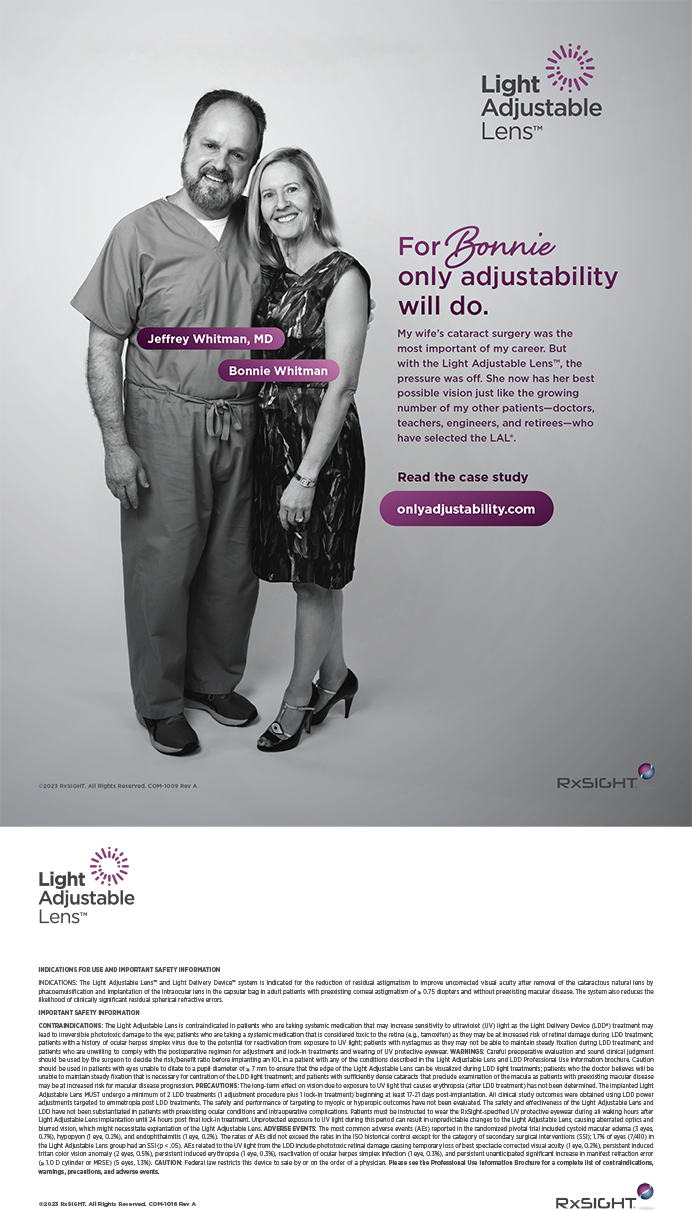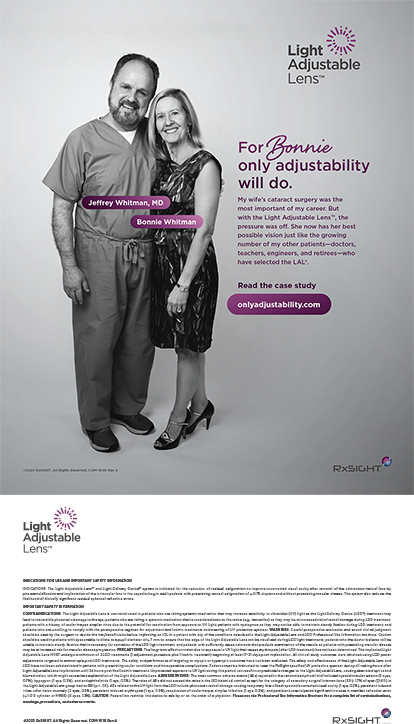The method for creating an anterior capsulorhexis has changed considerably over time, and surgeons continue to refine their approach with novel techniques and innovative technologies. Introduced in the 1980s by Gimbel and Neuhann,1 the continuous curvilinear capsulorhexis (CCC) increased the strength of the capsulotomy, which, in turn, improved the stability of the implanted IOL. Although the CCC remains the gold standard for modern cataract surgery, the technique can be challenging to execute in cases of zonular instability, poor pupillary dilation, shallow anterior chambers, corneal scarring with a hazy view, and hypermature cataracts associated with positive pressure on the capsule. Creating a centered capsulotomy of a precise size can be especially difficult for surgeons in training,2 and there is a lack of consensus regarding the best and safest way to create the ideal capsulorhexis. Various instruments and devices have been developed to facilitate the creation of a capsulotomy.
TRADITIONAL METHOD
After filling the anterior chamber with viscolelastic, most surgeons begin the capsulotomy by creating a small incision in the anterior capsule with a cystotome. Next, they manually advance the resulting capsular flap into a circular shape by guiding the leading edge with the cystotome. Alternatively, surgeons may pull the capsular flap in a circular fashion by grasping the leading edge with a forceps and advancing the tear with frequent regrasping. A Utrata forceps is most commonly used for this step, but a Duet forceps (MicroSurgical Technology), which is designed to be effective through a sub-2-mm incision is becoming more popular (Figure 1).
Oftentimes, surgeons center the capsulotomy by using Purkinje reflexes as a guide. The capsular opening should have a diameter smaller than that of the IOL’s optic, which is generally 6 mm. Too small a capsulorhexis may make nuclear disassembly difficult, place considerable stress on the zonules during nuclear removal, and promote postoperative capsular phimosis. Too large a capsulorhexis may allow the IOL’s optic and haptics to dislocate anteriorly out of the capsular bag, which might lead to imprecise effective lens positioning and could damage sulcus tissues.
Refractive outcomes are influenced by the centration and size of the capsulorhexis. A properly sized and well-centered capsulotomy with 360º of anterior capsule-optic overlap reduces the risk of optic decentration, IOL tilt, myopic shift, and posterior capsular opacification.3-6 Okada and colleagues demonstrated that a capsulotomy decentered by more than 0.4 mm was associated with a 0.25 D change in spherical equivalency and that an incomplete capsulorhexis-optic overlap was associated with 0.50 D of induced astigmatism 1 year postoperatively.7
IN PURSUIT OF PRECISION
Surgeons and industry continue to strive to create instruments and devices to improve the accuracy of the capsulorhexis. The Fujimoto 5.3-mm CCC Guide (Crestpoint Management) and the Ota 5.6-mm CCC Marker with Center Pointer (Crestpoint Management) are designed to help surgeons create precisely sized and shaped capsulotomies. The Verion Image Guided system (Alcon) and Callisto Eye (Carl Zeiss Meditec) project a circular template of predetermined size on the anterior capsule intraoperatively. Prior to the introduction of these advanced systems, Samuel Masket, MD, filed a patent proposing a system that would allow surgeons to configure a target image to be projected and tracked using sensors during the creation of the capsulotomy (http://bit.ly/1vPVke3). Another embodiment proposed by the same patent uses a physical template that can be inserted into the anterior chamber to make an impression in or mark on the lens capsule.
Surgical devices designed to provide a visual guide on the anterior capsule have also been developed. The Raviv Capsulorhexis Caliper (Bausch + Lomb) has blunt, adjustable marking tips that indent the anterior capsule on two axes after they are inserted through the main cataract incision. The Confetti Caliper (Morcher), introduced in 2003, was a soft ring that could be inserted and placed on top of the anterior capsule, and trypan blue dye could then be injected into the ring. The resultant stained area on the anterior capsule served as a template for the surgeon during capsulorhexis formation. Unfortunately, the device did not work well and appears to have been abandoned by the inventors. The Morcher Ring Caliper (Morcher; distributed in the United States by FCI Ophthalmics) is a sterile, temporary polymer ring placed directly on top of the anterior capsule. After aligning the ring, the surgeon creates the capsulotomy while staying away from the inner margin of the ring. To facilitate the device’s insertion through a small incision, another visual aid was recently designed: an incomplete PMMA ring 5.3 mm in diameter.8
Some devices physically alter tissue to achieve a desired outcome. The Fugo Plasma Blade (Medisurg Research & Management) and the Pulsed Electron Avalanche Knife (Medtronic) have both been used to effectively and safely create a capsulotomy.9,10 Bausch + Lomb developed a device that applies electromagnetic induction heating to create a precisely sized and centered capsulorhexis (http://bit.ly/1nc7KOd). A primary conducting coil external to the eye projects magnetic field lines into a secondary conducting coil that has been placed onto the anterior capsule. The surgeon tears along the resultant burn line to create the capsulorhexis. Clinical data on this device are not currently available. Mynosys Cellular Devices is developing a device that automates capsulorhexis formation by applying suction to the anterior capsule, and a mounted cutting element incises the anterior capsule along that template (http://bit.ly/1vPXoCK).
THE ERA OF LASER SURGERY
Laser cataract surgery holds great promise for creating predictably sized, well-centered anterior capsulotomies, even in eyes with zonular instability and hypermature lenses (Figure 2). Numerous studies have demonstrated that capsulotomies created with the laser are more precise in terms of size, centration, and postoperative IOL alignment compared with manual capsulotomies.11,12 Other studies suggest that improved centration and morphology do not affect refractive outcomes.13 Furthermore, an investigation using scanning electron microscopy showed that capsulotomies made with a laser resembled a micro-can opener with a zippered or jagged edge.14 These small perforations are likely the result of fixational eye movements during laser treatment. One multicenter study reported a 16-fold increase in radial tears after laser-assisted capsulotomy compared to manually created CCCs.14 This finding has raised questions regarding the integrity of laser-assisted capsulotomies, and further longitudinal studies are needed to assess whether the microperforations will have long-term adverse effects on patients’ outcomes. It should be noted that many surgeons who perform laser cataract surgery have not experienced problems with tags or rents that might be due to variability between lasers. The improvements that are being made to the various laser platforms also appear to be enhancing outcomes of capsulotomies when compared to the manual CCC technique.15
Despite the promise of femtosecond laser-assisted capsulotomies, the cost of laser technology will likely prevent surgeons from transitioning entirely away from manual capsulotomies, especially in developing countries. A unique aspect of laser-assisted capsulotomies is that the same laser can be used to perform corneal incisions and segment the lens, something that the previously discussed devices are unable to accomplish. As the laser platforms become more versatile in ophthalmic surgery, including for glaucoma and retina surgery, the cost of buying the machine may become more economically feasible for practices around the world.
MOVING FORWARD
The progression from the can opener technique to the CCC was a major advance that led to innovations in the procedure and IOL design. To perfect the precision of this difficult maneuver, many devices have been patented, although few have made it to market for general use. Marking the cornea, projecting light onto the anterior capsule, and inserting a presized device into the anterior chamber may help the surgeon by providing visual aids to correctly and reproducibly size and center the capsulorhexis. Visual aids still involve a significant amount of imprecision, however, because they do not inherently assist with the formation of the capsulorhexis. Thermal, electromagnetic, and mechanical cutting instruments have not seen wide adoption due to cost and a decrease in the integrity of the capsulorhexis compared to that of the manual CCC. The recent introduction of the femtosecond laser could improve the predictability and precision of the capsulotomy, although the increased cost and alteration in OR flow still present obstacles to wide adoption. One thing is certain, ophthalmologists and industry members will continue to develop new ways to assist surgeons of all experience levels to perform a precisely sized and centered capsulorhexis.
Kevin Gamett, MD, is a faculty fellow at the University of Colorado Eye Center in Aurora. He acknowledged no financial interest in the products or companies mentioned herein. Dr. Gamett may be reached at kevin.gamett@ucdenver.edu.
Malik Y. Kahook, MD, is the Slater family endowed chair in ophthalmology; vice chair, clinical and translational research; and director, Glaucoma Service and Glaucoma Fellowship, for the Department of Ophthalmology at the University of Colorado Eye Center in Aurora. He is a consultant to Alcon and has patent interests with Abbott Medical Optics and Mile High Ophthalmics. Dr. Kahook may be reached at (720) 848-2020; malik.kahook@ucdenver.edu
Leonard K. Seibold, MD, is an assistant professor of ophthalmology at the University of Colorado Eye Center in Aurora. He acknowledged no financial interest in the products or companies mentioned herein. Dr. Seibold may be reached at leonard.seibold@ucdenver.edu.
Jeffrey R. SooHoo, MD, is an assistant professor of ophthalmology at the University of Colorado Eye Center in Aurora. He acknowledged no financial interest in the products or companies mentioned herein. Dr. SooHoo may be reached at jeffrey.soohoo@ucdenver.edu.
- Gimbel HV, Neuhann T. Development, advantages, and methods of the continuous circular capsulorhexis technique. J Cataract Refract Surg. 1990;16:31-37
- Dooley IJ, O’Brien PD. Subjective difficulty of each stage of phacoemulsification cataract surgery performed by basic surgical trainees. J Cataract Refract Surg.2006;32:604-608
- Hollick EJ, Spalton DJ, Meacock WR. The effect of capsulorhexis size on posterior capsular opacification: one-year results of a randomized prospective trial. Am J Ophthalmol. 1999;28:271-279
- Ravalico G, Tognetto D, Palomba M, et al. Capsulorhexis size and posterior capsule opacification. J Cataract Refract Surg. 1996;22(1):98-103
- Aykan U, Bilge AH, Karadayi K. The effect of capsulorhexis size on development of posterior capsule opacification: small (4.5 to 5.0mm) versus large (6.0 to 7.0mm). Eur J Ophthalmol. 2003;13(6):541-545
- Ram J, Pandey SK, Apple DJ, et al. Effect of in-the-bag intraocular lens fixation on the prevention of posterior capsule opacification. J Cataract Refract Surg. 2001;27(7):367-370
- Okada M, Hersh D, Paul E, van der Straaten D. Effect of centration and circularity of manual capsulorhexis on cataract surgery refractive outcomes.Ophthalmology. 2014;121(3):763-740
- Kim S, Lee Y, Hwang K, Joo C. Usefulness of open ring guider for continuous curvilinear capsulorhexis. J Korean Ophthalmology Soc. 2013;54(10):1494-1500
- Singh D. Use of the Fugo blade in complicated cases [letter]. J Cataract Refract Surg. 2002;28:573-574
- Palanker D, Nomoto H, Huie P, et al. Anterior capsulotomy with a pulsed-electron avalanche knife. J Cataract Refract Surg. 2010;36:127-132.
- Kránitz K, Takacs A, Miháltz K, et al. Femtosecond laser capsulotomy and manual continuous curvilinear capsulorhexis parameters and their effects on intraocular lens centration. J Refract Surg. 2011;27:558-563.
- Naranjo-Tackman R. How a femtosecond laser increases safety and precision in cataract surgery? Curr Opin Ophthalmol. 2011;22:53-57.
- Findl O. Influence of rhexis size and shape on postoperative IOL tilt, decentration and anterior chamber depth. Paper presented at: The XXXI Congress of the ESCRS; October 7, 2013; Amsterdam, Netherlands.
- Abell RG, Davies PE, Phelan D, et al. Anterior capsulotomy integrity after femtosecond laser-assisted cataract surgery [published online ahead of print September 28, 2013]. Ophthalmology. doi:10.1016/j. ophtha.2013.08.013.
- Bala C, Xia Y, Meades K. Electron microscopy of laser capsulotomy edge: interplatform comparison. J Cataract Refract Surg. 40(8):1382-1389.


